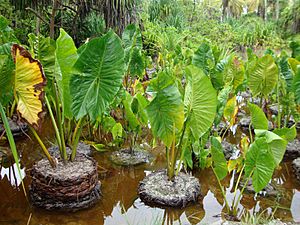Cyrtosperma merkusii facts for kids
Quick facts for kids Cyrtosperma merkusii |
|
|---|---|
 |
|
| Babai cultivation in Butaritari, Kiribati. | |
| Scientific classification | |
| Genus: |
Cyrtosperma
|
| Species: |
merkusii
|
| Synonyms | |
|
|
Cyrtosperma merkusii, also known as giant swamp taro, is a special plant grown in many parts of Oceania, South Asia, and Southeast Asia. It's a bit like regular taro, but it grows much bigger. This plant loves wet, swampy places, like near rivers.
Even though we don't find it growing wild today, experts believe it originally came from Indonesia. This important plant has many different names depending on where you are. For example, it's called babai in Kiribati, pulaka in Tuvalu and Tokelau, and palawan in the Philippines.
In tough places like the small atoll islands of Tuvalu and Kiribati, giant swamp taro is super important. It provides lots of carbohydrates, which are energy foods. People on these islands mostly eat fish and coconut, so this plant adds important nutrients. Growing it takes a lot of effort and time, but it's a big part of their culture.
The roots of this plant need to be cooked for many hours. This is to remove natural chemicals that can make you feel tingly or itchy if eaten raw. But once cooked, they are full of good nutrients, especially calcium. Sadly, growing this plant is becoming harder because of rising sea levels. Also, more imported foods are being used, which sometimes means less focus on traditional crops.
In Nepal, giant swamp taro is called mane. It grows in warm forests near streams. People gather it in January or February. All parts of the plant, like the leaves, stems, and roots, can be eaten after being boiled and roasted. The stem needs extra long boiling to remove those irritating chemicals. If prepared carefully, the roots taste like taro, and the leaves are like spinach.
Meet the Giant Swamp Taro
Giant swamp taro is the biggest type of root crop in the Taro family. These plants are grown all over Southeast Asia and the Pacific. Even though it looks a bit like the common taro (Colocasia esculenta), it's actually from a different plant group.
This amazing plant can grow very tall, sometimes reaching 4 to 6 meters (about 13 to 20 feet) high! Its leaves and roots are much larger than regular taro. The leaves can be up to 2 meters (6 feet 7 inches) long and 120 centimeters (4 feet) wide. They grow on thick stalks that can be up to 6 meters (19 feet 6 inches) long.
Giant swamp taro is quite strong against most plant diseases and pests. However, it can be affected by the taro beetle. The main part people eat is the corm, which is the big underground stem. This corm can weigh as much as 100 kilograms (220 pounds) and be 1 meter (39 inches) wide! It's starchy and can be cream or pink inside. It tastes a bit like sweet potato, but it's drier.
How This Giant Plant Grows
Giant swamp taro is not a plant that likes dry land or just rainwater. It has learned to grow best in fresh water and coastal swamps. It can handle some shade and is a little bit tolerant of salty water compared to other taro plants. This means it can grow in slightly brackish (a bit salty) water. It grows slowly, sometimes taking up to 15 years to be ready for harvest!
This plant is one of the only crops that can grow on low-lying coral atolls. On these islands, people dig special pits down to the level of the freshwater lens. The freshwater lens is like a layer of fresh water floating on top of salt water underground.
Growing Pulaka in Tuvalu and babai in Kiribati is very important culturally. But in these difficult environments, its growth is now threatened by rising sea levels. This is happening because of global warming. The plant doesn't do well in salty water, which can rot its roots, turn its leaves yellow, and stop it from growing.
Climate change affects the plant in two main ways. First, more frequent droughts make the underground fresh water saltier. Second, very high tides and coastal erosion allow seawater to get into the growing pits.
In the Philippines, giant swamp taro is known by names like palawan or payaw. People often grow it and harvest its corms in the Visayas and Mindanao regions. They usually cook it in similar ways to other taro dishes. It's also sometimes used as a sweet filling for pastries.
Getting It Ready to Eat
Giant swamp taro has natural chemicals that need to be removed. This is why it must be cooked for a long time. A great thing about this plant is that its corms can stay in the ground for a very long time, even up to 30 years or more! Because of this, it has traditionally been a very important emergency food. It helps people when there are natural disasters or not enough food.
After the corms are cooked, they can be dried in the sun. This allows them to be stored for later use. People in different places, like Tuvalu and Kiribati, have their own special ways of preparing pulaka and babai.
In the Philippines, where this plant grows wild in swamps, people harvest the corms for food. They let it grow for years until the plant is big and has good tubers. The harvested corms are cooked and are very starchy. Unlike other taro types, it's not always grown on purpose for its corms. It often just grows naturally in wet, swampy areas. The Waray people call it Palawan, and it's a popular food for them.

